This Monday started great, as advisor and physical agents specialist I have received this requestM
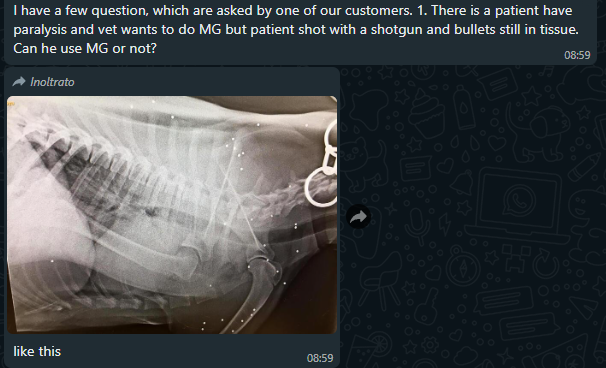
“wants to do Magnetotherapy but the patient shot with a shotgun and bullets still in tissue. Can he use magneto therapy or not?”
The patient obviously isn’t a man, is a dog. Pretty sure this is a classical “hunting injury”, where unfortunately the dog got hit.
My first think was pretty clear but as usual, I’ve stopped to think for 10 sec, with the conclusion to give a deep look, in order to give a proper and solid response.
Are bullets and pellets safe with physical agents?

bullets and pellets inside the patient
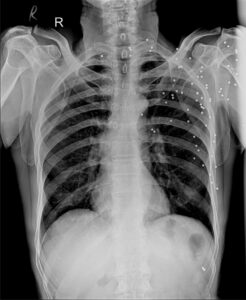

Is more common than you think: hunting is spread all around the world and getting hit by a pellet is one of the most common hunting injuries. Usually, these pellets aren’t removed, especially when deep in muscle tissue and dozens: pellets are well tolerated by human tissues, remove them makes more damage than the pellets themself.
Keep in mind: pellets come from shotshells, buckshot shot by hunting rifles and shotguns. Usually are made of LEAD, but someone are made of steel and copper. Is primary know the metal, usually starting from the pellets caliper or context (hunting, crime, war).
Different story with bullets. The bullet is the mobile part of the cartridge, is the kinetic part that leaves the case and hit the target. Handguns, rifle, assault rifle, war rifle use different caliper and kinds of bullets. Usually are mad of LEAD, where we can find:
- FMJ: full metal jacket, covered with hard metal as COPPER
- Hollow point
- Soft point
To make it simple, there is always some copper around or in the back of the bore, an important aspect to keep in mind.
Usually, a bullet is always removed from the body of the patient, except when is fragmented with pieces closer to vital organs.
This scenario is not so unusual, especially if the patient comes from a region such as the middle est (Palestine, Afghanistan, Iraq) or east Europe (Ex-Yugoslavia, Balcans, Ukraine…). Personally, I had from boys to adults, coming from ex-war zone, with pieces of bombs, bullets and pellets. In countries like Palestine or even Croatia is a daily scenario face patients with metal inside.


fragmentation, shards or splinters inside the Patient
Here things become complicated: splinters comes from anti-personnel weapon, bomb, barrel bomb, land mine, IED, artillery, mortar, tank gun, autocannon shell, rocket, missile, grenade, etc. . They are dispersed and/or shattered by the detonation of a primary device (Wikipedia)

Is pretty hard discover the nature, the material of the splinters, but usually steel, iron, copper and similar alloy, with magnetic or diamagnetic properties.
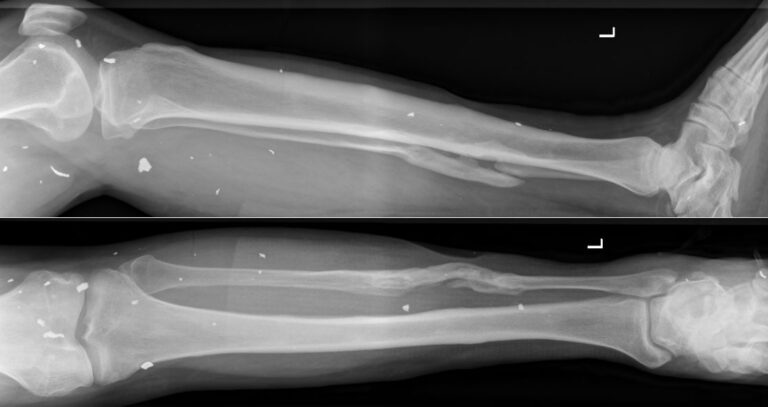
Like to me, may happen that the radiologist doesn’t know the nature of the fragmentation, pretty natural in countries without war experience like Italy and they simply report “artifacts“.
In this picture, a CT scan, you can see the typical artifact created by metal pieces. I’ve seen until 25pieces in the lumbar back of an ex-soldier coming from Sarajevo, hitten indirectly by artillery ammo (1991 is not far in history, with all respect to the actual situation in Ukraine, before it, a war in Europe was not so far in time).
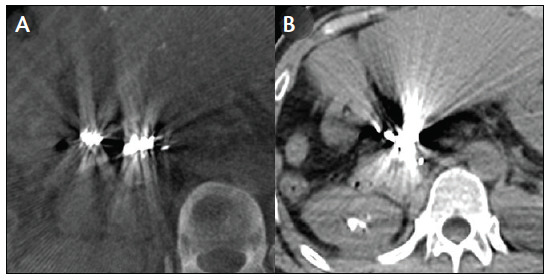
Is Lead magnetic?
Basically, the atom is paramagnetic but the metal is diamagnetic. Its lower magnetic susceptibility, higher resistance and magnetic permeability of 1, made lead totally indifferent to magnetic fields.
And pulsed magnetic field? Change something?
Reading “MRI issues for ballistic objects: information obtained at 1.5-, 3- and 7-Tesla” (summary here) we can see how between 1 – 3 tesla, lead and ferromagnetic bullets are basically safe during an MRI.
In rehabilitation, we can use pulsed magnetic field therapy with intensity until 100 or 300 gauss (0,01 and 0,03 Tesla) and frequencies around 1-200Hz. Recently we are seeing the rising of the new devices as “super inductive field therapy” with intensity until 3 TESLA, working at frequencies around 1-150Hz. Usually, homecare devices are set with protocols until 8 hours but intensity around 30 gauss with very short rectangular pulses.
We can simply conclude that magnetic therapy in presence of LEAD pellets and bullets is basically safe.

ferromagnetic bullets are safe with magnetic therapy?
Copper, iron and steel are ferromagnetic. Recent research done on humans seems to prove that even ferromagnetic bullets are safe for MRI in a specific scenario:
- bullet in muscle, tendon or bone tissue.
- not inside or closer to vital organs.
- old injury: the bullet is engulfed by fibrous tissue, is stable!
So, if the injury isn’t recent, considering the characteristics of actual devices, magnetic therapy is basically safe. Considering how usually people live a normal life with pellets or splinters within, if the injury is old, also manual manipulation is safe.
Bullets and pellets are safe with other physical agents?
Basically this structures, can do 2 simples things:
- storage heat
- reflect mechanical forces
- work as antennas for electromagnetic fields
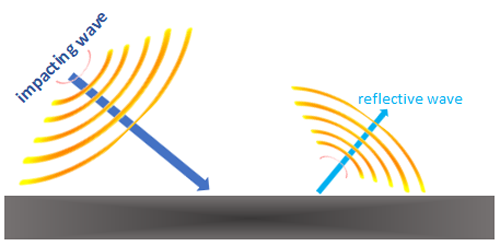

So, with thinking and in agreement with Electrophysical Agents in Physiotherapy (Physiotherapy Canada volume 62 number 5), we can assume:
Ultrasounds:
Metal reflects about 90% of incident ultrasounds, and is not heated by therapeutical ultrasounds. The stable application requires caution to avoid standing waves or cavitation (page 18).
High Power Laser:
Thermal should be avoided if the metal is closer to the skin. Metal acts as an accumulator of heat, releasing it through time even after the application.
Non-thermal application is safe: there is no indication in the literature, and the rationale of physics leads to this conclusion. The paper of reference declares thermal therapy safe over metal implants (page 52).
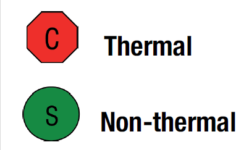
Electrical Stimulation:
The application of every kind of e-stim and current is safe (page 33).
Shortwave and Microwave:
The thermal application should not be used in the vicinity of the metal: it doesn’t heat, but could potentially burn soft tissue around as result of interactions of an electromagnetic field with the metal.
A pulsed application can be applied, not over 5W, but there is no consensus. (page 67).

Long Wave Diathermy (TECAR):
This technology is relatively recent, maybe less diffused outside Italy, Spain and other closer countries. Tecar uses a 400-450Khz sin wave, with power until 200-300watts. So is an electric current, with high penetration in the human body and energy. Personally, I suggest:
- RESISTIVE MODE: Don’t with fragmentation along the path of the current. Yes with rounded pellets.
- CAPACITIVE MODE: Yes, also over frags and pellets.
Generally don’t exceed with heating, work athermal and homeothermic way.
Shockwave Therapy:
As ultrasounds, RSWT and FSWT are mechanical therapy, a sound wave with higher speed and force. Keep in mind that metals reflect these waves, spreading energy and precision.
This is not a contraindication, but at least a counter sense: an RSWT over an area with several pellets, may lead to a reduced effect or null. You even “risk” affecting more other areas respecting your target.
It’s all linked to how many pellets we have in the area of treatment and their size.
Assessing the Probability of Ferromagnetism in bullet and pellets
Some indications taken from this website about MRI questions:
- All bullets and shrapnel acquired in military service or overseas should be considered ferromagnetic unless proven otherwise.
- All BB’s and pellets should be considered ferromagnetic.
- All shotgun pellets should be considered ferromagnetic, although about half are not. Pellets that distort into multiple irregular (non-rounded) shapes are more likely to be made of lead.
- Bullets from pistols and handguns in the USA virtually never contain steel, as their manufacture and sale (but not possession) has been a federal crime since the attempted assassination of President Reagan in 1986.
- Bullets from domestic handguns implanted more than 25 years ago should be considered ferromagnetic out of extra caution, although the probability is low.
- Armor-piercing steel-jacketed and steel-cored bullets can and are legally sold for use in rifles in the USA and elsewhere. Being so powerful/penetrating they would likely pass straight through a person unless stopped by a large bone. Although the probability is small that a domestic rifle bullet found on screening would be ferromagnetic, it should be assumed to be so out of caution.
- Steel jacketed ammunition represents a large amount of “non-defense” ammunition (i.e., that meant for target practice)
- “Defense” ammunition, synonymous with a hollow point or expanding ammunition, never contains a steel jacket as it does not aid in projectile expansion and fragmentation
- Some superficially located ferromagnetic pellets and bullets may be positively identified by a hand-held ferromagnetic metal detector; but a negative reading should be considered inconclusive.
- Some investigators have proposed using expanded range dynamic CT or dual-energy CT to determine bullet composition, but to date the results have been variable.
- A final interesting approach has been recently proposed by Fountain et al (2021). The method involves looking at the projectile on x-ray and noting either if it is deformed (in the absence of hitting bone) or has left a debris trail. Either of these features implies a lead or other non-steel composition that is relatively “soft”, having been designed to disperse its energy upon impact. If you don’t see deformity or a debris trail you still may have a lead projectile, but you should probably treat it as though it might be ferromagnetic. I have not personally used this method, but it makes sense.
References
-
Natural history of pellets inside human body, a prospective observational study Azher Mushtaq DOI: 10.15761/TEC.1000156
-
Jim H (2014) Hunting with airguns. Crosman. Retrieved 10 December 2014.
-
Thoresby FP, Darlow HM (1967) The mechanisms of primary infection of bullet wounds. Br J Surg 54: 359-361.
-
Mushtaque M, Mir MF, Bhat M, Parray FQ, Khanday SA, et al. (2012) Pellet gunfire injuries among agitated mobs in Kashmir. Turkish Journal of Trauma & Emergency Surgery 18: 255-259.
-
MRI issues for ballistic objects: information obtained at 1.5-, 3- and 7-Tesla Published: April 05, 2013